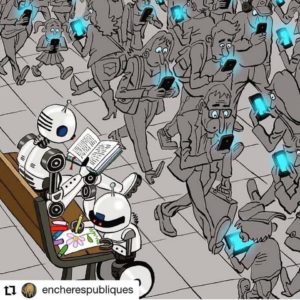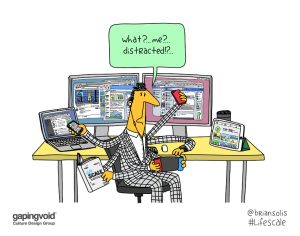Guest post by Rajat Paharia (@rajatrocks), founder and chief products officer, Bunchball and author of Loyalty 3.0: How to Revolutionize Customer and Employee Engagement with Big Data and Gamification
2015 promises to be The Year of Customer Experience. Companies around the globe are resolving to become more customer-centric because, as Brian lays out quite eloquently in his book:
“Now’s the time for an investment in something more than price, performance, or value. The future of business is about creating experience, products, programs, and processes that evoke splendor and rekindle meaningful and sincere interaction and growth.”
However, I find that when marketers talk about customer experience, most tend to focus exclusively on the buyer, the customer. The discussions revolve around questions like “What does the customer want/need/prefer?” and “How can we improve customer engagement?”
That’s unfortunate.
Yes, you read that correctly. I’m writing today to tell you that while focusing on the customer is extremely important to any business’s long-term strategy, focusing on the customers’ wants alone is not. Furthermore, when you continually emphasize customers above all others, you run the very real risk of ignoring the most critical component of the larger service-profit chain: engaged employees.
Sure, satisfied, loyal customers are essential to profitability. But make no mistake about it: The entire service-profit chain begins with, and absolutely depends on, engaged employees.
“Engaged employees.” Who are they? They’re the kind of employees who are motivated to do well. They’re involved, invested, well-trained – and because of all those things, they make customers happy. Companies can spend millions on splashy marketing campaigns designed to attract customers, but at the end of the day, employees are the ones who make – or break – the customer experience.
Now you’re probably thinking, “Okay, I get it. Companies need engaged employees. Fine. What’s the problem?”
Here’s the problem: By and large, engaged employees are an endangered species. Very few currently exist, and in a world that’s becoming ever more complicated and full of distractions, they’re becoming increasingly rare. As Brian pointed in December, employee engagement is at an all-time low. Gallup found that only 13 percent of workers actually feel engaged at their jobs. Even worse, 63 percent of workers are not engaged at all.
If employees aren’t engaged, they’re not invested in the customer experience. So, no matter what your marketing campaign tells your customers, and no matter how you try to engage them, the whole experience is likely to fall flat – because most employees can’t deliver. They aren’t adequately trained (and/or updated). They aren’t properly incentivized. They aren’t responsive. And they aren’t motivated.
Fortunately, there is something you can do to change all that. It’s called gamification.
Gamification is about using data to motivate people, and these days, nearly everything we do at work (and everywhere else!) has data associated with it. Therefore, employers can now leverage data generated in the workplace to gain insights into business performance. In short, gamification enables employers to motivate the employee behaviors needed to drive a great customer experience.
Some of you may read the term “gamification” and dismiss it as something to do with games, meaningless badges and prizes, or otherwise tricking people. But that’s not true gamification. Done right, gamification is a powerful business tool, and companies around the world are using it to improve performance across a wide range of parameters. Throughout the year, you’re going to be hearing more and more about successful gamification initiatives, the kind that are:
Based on business strategy. To be effective, a gamification platform must tap into your employees’ intrinsic motivators. Plus, it has to marry these motivators to your particular business strategy. In other words, you need to make sure you’re inspiring the right behaviors, the ones that will help you achieve your goals – not the behaviors that reward short-term successes at the expense of long-term business objectives.
Integrated. Why reinvent the wheel? As I already mentioned, modern employees are walking data-generators. An effective gamification platform includes technical integrations that pull data into/from the systems you already have in place (your point of sale system, your system for employee performance reviews, etc.).
Grounded in analytics. A gamification platform must be able to measure business impacts, and it must be scalable and sustainable. An effective gamification platform offers continual motivation, real-time feedback, performance gains and business insights.
How does this all come together to improve the customer experience? Check out these recent results:
In order to provide superior customer support and issue resolution, a major telecommunications company needed to motivate customer care and retail representatives to make the company’s online social business community their go-to resource for knowledge-sharing. After incorporating a gamification platform, the company increased employee participation by 1,000 percent and engaged more than 30,000 frontline representatives, empowering them to more effectively respond to customers’ queries. This increased engagement translated to improved customer care, as illustrated by a 6,000 percent increase in the “likes” awarded for helpfulness and accuracy on peer responses to community questions.
In another example, managers at a major manufacturer wanted to improve the effectiveness of training resources and drive informal learning for sales and service reps across 450 store locations. After they integrated gamification into the company’s Learning Management System, site usage increased 417 percent versus the same period the previous year. Engagement and volunteer learning rose dramatically, too, with many participants completing courses above and beyond the requirements for annual certification. In addition, the company found a positive correlation between engagement and key performance measures – the top 10 percent of those who participated in the gamification program saw a 15-18 percent increase on in-quarter sales and also improved customer satisfaction metrics.
As you can see from these examples, gamification is not one-size-fits-all. To be effective, your gamification platform must be customized to your business and your people. It must capture the right data and provide the right insights. Then –and only then –you’ll be able to use gamification to truly motivate your employees to deliver an exceptional customer experience. And hopefully, I’ve convinced you that that’s now what is at the core of successful marketing. In 2015, and going forward from there, any company that wants to stay competitive will have to offer an exceptional customer experience, the kind that only engaged employees can deliver.
Image Credit: Shutterstock






Sounds like you’re talking about data-driven empathy – I like it! As more customer facing touch points become digital (because they’re convenient) it’s increasingly possible to track them. The trick is to take that massive amount of technical data and present it in a compelling way to people who can act. Adding the gamification layer is great way to get people to want to do the most important things.
Have you come across any tools which represent digital customer journeys in a compelling visual way in realtime?
Company that I work for has implemented a gamification platform before using our SaaS tool. Every client that uses the gamification platform first sees better results later on.
Absolutely. We @mypoolin:disqus are a huge fan of gamification
Hello,
It is really a nice article on delivering great customer experience. The post contains nice and practical points to implement in real practice. I am happy that I found something influencing.
Thanks
Pi technologies Pvt. Ltd, Indore.